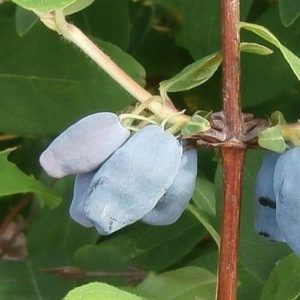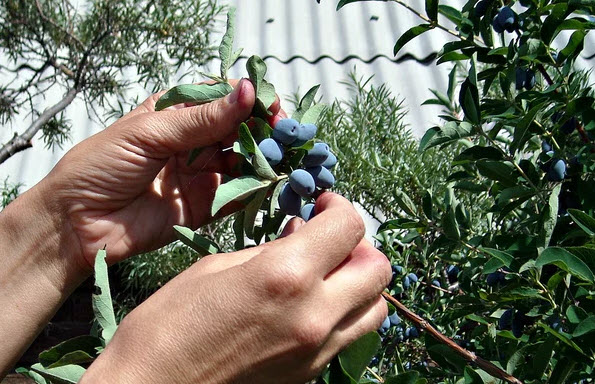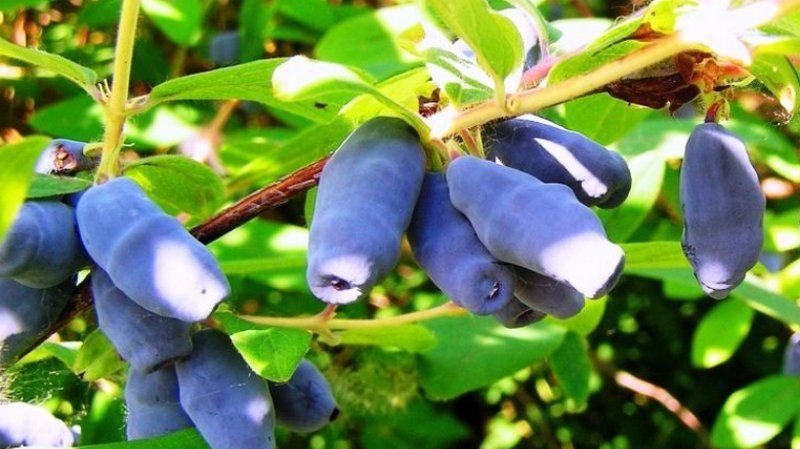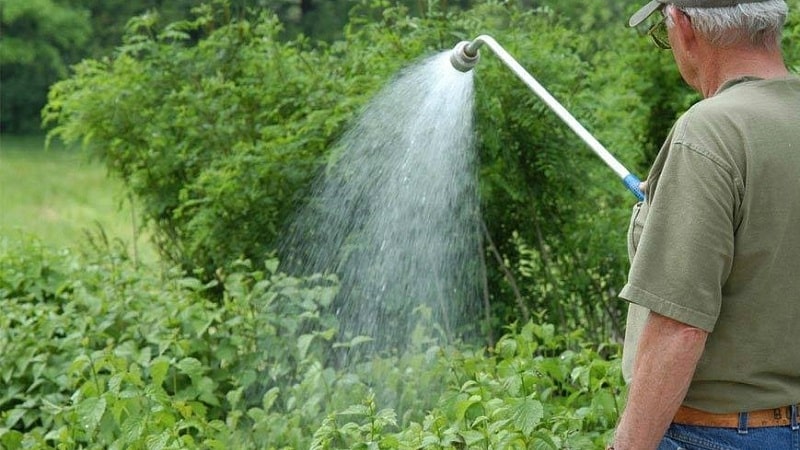High-yielding frost-resistant honeysuckle variety Moskovskaya 23
Honeysuckle Moskovskaya 23 is a high-yielding variety that opens the summer season. It received its name in honor of the German botanist and physician Adam Lonitzer, who lived in the 16th century. Moskovskaya 23 gives gardeners tasty and juicy fruits containing vitamin C (65 mg per 100 g). There are very few reviews about this honeysuckle, but they are only positive, so it’s worth growing the variety on your site.
Description of honeysuckle variety Moskovskaya 23
This is a high-yielding variety with early ripening. The fruits are saturated with vitamin C, dry substances in the amount of 12.8%, sugars - 5.8%, organic acids - 2.9%.
Origin and development
The variety was developed by domestic breeders in 1985. We got it in the Main Botanical Garden of the Russian Academy of Sciences named after N.V. Tsitsin through free pollination edible honeysuckle blue. Included in the State Register in 1998 and approved for cultivation in all regions of the Russian Federation.
Description of appearance and taste
The following characteristics will help describe this edible variety:
- Bush. Height and diameter - 1.9 m. The branches are erect, the shoots are brown-green. The leaves are elongated-oval, green, up to 6 cm long and up to 3 cm wide.
- Inflorescence. The flowers are medium-sized, light yellow, 2-flowered.
- Fruit. Blue-blue with a waxy coating. The shape is pear-oval with a tuberculate surface. The skin is dense, the flesh is fibrous. The weight of each berry reaches 0.8 g.
- Taste qualities. The berries have a sweet and sour taste, tartness, and a pronounced aroma.Tasting score: 3.9 points.
Features of application
Since honeysuckle Moskovskaya 23 is an edible variety, its fruits are consumed fresh. The berries are great for making preserves and jams.
Productivity and ripening period
The average yield is 63.7 c/ha or 3-4 kg per bush. Ripening is uneven; berries are picked at the stage of biological ripeness. The fruits have an average degree of crumbling (2 points), the stalk is poorly separated - the berry is damaged when it is torn from the hand.
After planting, honeysuckle begins to bear fruit in 4-5 years.
Early ripening: from the end of May to the end of June (depending on the growing region).

Resistance to diseases and pests
The variety is affected by reddish-olive spotting and powdery mildew. Resistant to mosaic and mottling foliage. The plant is attacked aphid, honeysuckle miner, sawfly, false scale insect, leaf roller, honeysuckle moth, mite.
Resistance to cold and drought
The bushes have good resistance to low temperatures down to -40°C and short-term drought. To maintain soil moisture, cover the roots with hay or straw mulch.
For which regions is it best suited?
Honeysuckle Moscow 23 is cultivated in all regions of the Russian Federation, since it is undemanding to growing conditions.
Advantages and disadvantages

Advantages:
- early ripening of berries - they appear the very first in the garden;
- unpretentiousness to growing conditions and care;
- Great for creating a mini garden;
- fast growth rate;
- suitability of fruits for transportation;
- high vitamin C content in berries.
Flaws:
- requires pollinators;
- berry sizes;
- sour taste.
Difference from other varieties and hybrids
Main differences:
- suitability for cultivation throughout the Russian Federation;
- high concentration of vitamins;
- presence of sourness in taste;
- average fruit shedding;
- difficult to separate the berries from the brush.
Agricultural technology
To get a good harvest, experienced gardeners recommend following the rules growing. Agricultural technology includes a competent choice of location for planting bushes, compliance with care rules, disease and pest control.
Choosing a place in the garden and preparing holes
Honeysuckle grows well in a lighted area without drafts or partial shade. Likes it wet, but not swampy soil. The location of groundwater is no closer than 1.5 m to the surface.
The pits are prepared at the end of September or October. The layout of the holes is 40x40x40 cm. Pollinator varieties are planted between each honeysuckle bush Moskovskaya 23. Maintain a distance from each other of about 1.5 m.
Preparatory work is carried out at soil and air humidity of at least 80%, air temperature - +15°C, soil temperature - +8°C.

Preparing for landing
2 hours before planting, the holes are watered generously with warm water. At the same time, the roots of the plants are placed in water for 20 minutes. Growth stimulants “Kornevin” or “Heteroauxin” are added.
Soil requirements
The plant prefers nutritious, neutral or slightly alkaline soil. Poor soil is enriched with manure, compost or humus, followed by digging. The acidity of the soil is adjusted to normal by adding crushed chalk or dolomite flour.
Dates, scheme and rules of planting
Honeysuckle is planted from mid-September to October. Keep the dimensions of the holes 40x40x40 cm, the distance between them is 1.5 m.
Landing instructions:
- The excavated soil from the hole is mixed with 10 kg of humus, 300 g of ash, 100 g of superphosphate, 30 g of potassium sulfate.
- The hole is filled with soil mixture to form a mound. A seedling is placed on it, carefully straightening the roots. The root collar is buried 4 cm.
- Cover with soil and compact well.
- Grooves are made around the bush and 10 liters of water are added.
- After the liquid is absorbed, the soil around the plant is mulched with hay, straw or humus.
Features of cultivation

The main requirement is to maintain optimal soil moisture under honeysuckle (at least 85%). After each watering, replace the old mulch with fresh one. The bushes must be watered with a hose with a sprayer to saturate the greenery and bark with moisture.
Watering nuances:
- in one season the bushes are watered 7 times, in drought - 14-15 times;
- Up to 15 liters of water are poured under one plant;
- during the period of formation of ovaries and filling of berries, increase the volume of liquid to 30 l;
- loosen the soil, lay a fresh layer of mulch.
Lack of moisture affects the yield and taste of fruits. During the rainy season, watering is stopped, otherwise the bushes will quickly become infected with viruses and infections.
For the first 2-3 years, honeysuckle does not require fertilizing. Then the bushes are fertilized with organic matter once every 2 years. To do this, at the end of October, add a mixture of 6 kg of compost, 100 g of ash, 40 g of double superphosphate per 1 sq. m. m.
Additional annual feedings are carried out:
- In mid- or late April, nitrogen-containing fertilizers are used. This is ammonium nitrate (15 g per 1 sq. m) or urea (15 g diluted in 10 liters of water, poured 1 liter under each bush).
- At the end of fruiting, use nitroammofoska or nitrophoska. The drug is dissolved in 10 liters of water, 1 liter is poured under each plant.
Honeysuckle is pruned regularly. During the procedure, adhere to the following tips:
- crown formation begins in the third season, in autumn, at a temperature of -3°C;
- cut out basal shoots, small branches that do not bear fruit, dry and lifeless shoots;
- leave 4-5 strong branches, the upper part of the shoots.
Experienced gardeners recommend planting honeysuckle next to dogwood, barberry, and black currant. This will prevent the appearance of ticks and leaf rollers.
Pollinators
Honeysuckle Moscow 23 is self-sterile. For pollination and berry formation, she needs other varieties: Viola, Blue Spindle, Amphora, Malvina, Blue Bird.
Disease and pest control

Honeysuckle Moskovskaya 23 is affected by diseases due to high humidity, thickening and rainy weather. Common ones are reddish-olive spot and powdery mildew. Signs are darkening of the stems, yellowing and falling leaves.
Diseases are eliminated using:
- chemical preparations “Skor”, “HOM” (strictly according to the instructions);
- prevention: in April and late October, the bushes are sprayed with Bordeaux mixture.
The main pests are aphids, honeysuckle miners and moths, mites, sawflies, leaf rollers, and false scale insects. Signs: eaten, curled leaves, growths on the bark. The fight is carried out using the drugs “Inta-Vir”, “Decis”, “Aktellik”, “Confidor”. Use according to instructions.
Important! If a mosaic or mottling of foliage is noticed, the berry bush is dug up and burned. There are no drugs against viruses, so it is useless to fight them. Disposal of affected plants will prevent the spread of infection to neighboring seedlings.

Preparing for winter
This variety does not require shelter for the winter. But the bushes are cleared of weeds, loosened and mulched. They put special nets over the plants to protect them from birds in winter.
Reproduction
Happens in 3 ways:
- By layering. In June, the top of the shoot is pressed to the ground, sprinkled and watered. Completely separated from the main bush only next year in the fall. Adhere to the landing rules described above.
- By division. Used for propagation of 5-year-old honeysuckle. At the end of August, the bush is divided into equal parts, leaving healthy roots and 3 branches. The resulting seedlings are planted according to the principle described above.
- By cuttings. At the end of October, annual shoots are divided into parts so that their length is about 20 cm. Then they are placed in a box with sawdust or sand and sent to the basement until spring. At the beginning of April, the cuttings are planted in a greenhouse, maintaining a tilt angle of 45°. They are transferred to open ground in early May, following the planting instructions described above.
Harvesting
The Moskovskaya 23 variety is characterized by uneven fruit ripening. Only ripe berries are collected every 2-3 days.
How and when to collect

The first ripe fruits are harvested in early June. They are torn off, placed in the refrigerator or eaten immediately. The shelf life of the variety is no more than 3 days without loss of taste.
Reference. The berries of this variety begin to fall off at the stage of biological ripeness. In order not to lose most of the harvest, gardeners lay out ordinary fabric under the bushes. Then the fallen fruits are collected.
Tips and reviews from experienced gardeners
There will be no difficulties in growing if:
- follow the landing rules;
- carry out systematic watering followed by mulching;
- maintain an optimal level of soil moisture;
- regularly inspect the berry garden for pests and signs of disease;
- harvest in a timely manner.
There are few reviews about the variety, but they are only positive.
Svetlana, Surgut: “Honeysuckle Moscow 23 has been growing for me for 6 years.I get a stable harvest - about 3 kg from one bush. The berries are tasty, but with a pleasant sourness. I grow Bluebird honeysuckle next to it.”
Marina, St. Petersburg: “I have been growing honeysuckle Moskovskaya 23 for about 9 years with the pollinator variety Malvina. The yield is satisfactory: I get 4 kg from one bush. I just water it and mulch the soil.”
Conclusion
Honeysuckle Moscow 23 is a high-yielding variety that is unpretentious to growing conditions, but requires pollinators and consideration of care nuances. If agricultural practices are followed, the gardener will receive an early, stable harvest of tasty and healthy fruits.